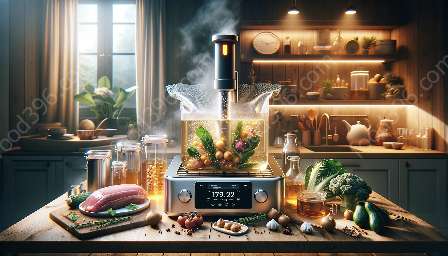Slow cooking has evolved as an essential culinary technique, offering extraordinary flavors, tenderness, and convenience. In this comprehensive guide, we'll delve into the various slow cooking methods, explore the compatibility of sous vide cooking, and uncover the importance of food preparation techniques for optimal results.
Understanding Slow Cooking Methods
Slow cooking refers to the process of cooking food at low temperatures over an extended period. This gradual approach enables the flavors to develop fully and ensures that tougher cuts of meat become tender and succulent. The following are some popular slow cooking methods:
- Braising: In braising, food is seared at high heat and then cooked in a small amount of liquid at low temperatures for an extended period. This method is ideal for tough cuts of meat, as the slow cooking process breaks down the connective tissues, resulting in incredibly moist and flavorful dishes.
- Stewing: Stewing involves cooking small pieces of food, such as meat or vegetables, in liquid over a long period. This method intensifies the flavors and ensures that the food is cooked thoroughly, resulting in rich and hearty dishes.
- Simmering: Simmering entails cooking food gently in a liquid at a temperature just below boiling. This method is often used for soups, sauces, and delicate ingredients to extract maximum flavor without overcooking.
- Slow Roasting: Slow roasting involves cooking food at low temperatures in the oven for an extended period. This method is perfect for large cuts of meat or whole poultry, creating incredibly tender and succulent results.
The Role of Sous Vide Cooking
Sous vide, which translates to 'under vacuum' in French, is a cooking method that involves sealing food in airtight bags and cooking it in a water bath at precise low temperatures for an extended period. This technique ensures even cooking and impeccable results, making it an ideal complement to traditional slow cooking methods.
Sous vide cooking offers precise temperature control, allowing the food to cook evenly while retaining its natural flavors and moisture. It also preserves the nutritional content of the ingredients, resulting in healthier and more vibrant dishes.
When integrated with slow cooking methods, sous vide enhances the tenderness and juiciness of meats, producing restaurant-quality results in the comfort of your home. Additionally, sous vide cooking enables the infusion of flavors and seasonings, elevating the overall taste profile of slow-cooked dishes.
Importance of Food Preparation Techniques
Efficient food preparation techniques play a vital role in achieving successful slow-cooked and sous vide dishes. Proper trimming and seasoning of meats, precise measurement of ingredients, and careful vacuum sealing contribute to the overall quality and flavor of the final dish.
Furthermore, the use of high-quality ingredients and attention to detail during the preparation stage ensures that the slow cooking and sous vide process can fully enhance the natural flavors and textures of the food. Sourcing fresh produce, using aromatic herbs and spices, and selecting premium cuts of meat are essential aspects of food preparation that significantly impact the outcome of the cooking process.
Tips and Recipes
To make the most of slow cooking methods, consider the following tips:
- Patience: Slow cooking requires patience, allowing the food to transform over time and develop rich, complex flavors.
- Flavor Infusion: Utilize herbs, spices, and aromatics to infuse the food with depth and complexity.
- Proper Sealing: When employing sous vide cooking, ensure proper sealing of the food to maintain integrity and prevent flavor loss.
Now, let's explore a delectable recipe that combines slow cooking and sous vide techniques:
Sous Vide and Slow-Cooked Short Ribs
This mouthwatering recipe showcases the fusion of sous vide and slow cooking, resulting in exceptionally tender and flavorful short ribs.
Ingredients:
- Beef short ribs
- Assorted aromatic vegetables (e.g., onions, carrots, and celery)
- Red wine
- Beef broth
- Bay leaves, thyme, and rosemary
- Salt and pepper
Directions:
- Season the short ribs with salt and pepper, then vacuum-seal them with the aromatic vegetables and herbs.
- Cook the sealed short ribs in a sous vide water bath at 140°F (60°C) for 48 hours, ensuring thorough immersion.
- After the sous vide process, carefully remove the short ribs from the vacuum bags and pat them dry.
- Sear the short ribs in a hot skillet to create a caramelized exterior, enhancing the visual appeal and flavor.
- In a separate pot, prepare a braising liquid with red wine, beef broth, and additional aromatics, then add the seared short ribs.
- Cover the pot and slow cook the short ribs in the oven at 250°F (121°C) for 6-8 hours until they are fork-tender.
- Once the short ribs are ready, serve them with the reduced braising liquid and enjoy the succulent and rich flavors.
By combining sous vide precision with the prolonged slow cooking process, these short ribs exemplify the extraordinary results achievable through innovative cooking techniques.

